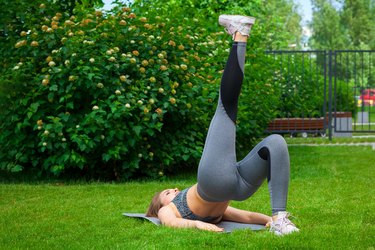
Your aching back may not be due to your back at all. Tight glutes and back pain often go hand in hand. Stiff or weak muscles in the hips and buttocks, or glutes, have a negative effect on your posture, resulting in back pain.
Ideally, your pelvis should be in a neutral position during daily life; if it's tilted to the rear, your back will tend to be overly flat. If your pelvis is tilted too far forward, you're more likely to have a sway back. Either of these posture aberrations can cause back pain due to the stress on muscles, ligaments and tendons.
Video of the Day
Video of the Day
Tip
Tight glutes symptoms often include lower back pain. Maintain good posture, stretch the glutes and hip flexors regularly and make sure the muscles supporting your back, including your glutes, are strong.
A Balancing Act
Your muscles are in a constant tug-of-war: when one set of muscles extends a bone or limb, the opposing set flexes the same limb. An imbalance between the muscles results in one set that is too loose and another set that is too tight.
Shortening a muscle for a long period of time makes it tight. Sitting for long periods keeps the hip flexors contracted and increases the risk that they will become tight. Sitting also causes weakness of the glutes due to lack of use.
Hip Flexors and a Weak Core
Because the hip flexors and gluteal muscles are attached to the pelvis, it causes a tilted pelvis and low back pain when the muscles are out of balance.
Your hip flexors raise the thigh toward the abdomen. When they are tight, they pull the pelvis forward and cause an excessive arch in the lumbar spine. They also may take over some of the functions of the abdominal muscles, which weakens your core — the abdominal and spinal muscles. A weak core also increases the risk of back pain.
Correcting the Problem
Stretching, massage and resistance training are ways to resolve the problem of glute and hip tightness. Stretching helps to correct muscle imbalances and loosen tight muscles.
Static stretching involves moving your body or limb into a posture and then holding that posture for at least 20 seconds. Try the kneeling hip flexor stretch, which is a kneeling lunge. Then lie on your back and pull one knee at a time into your chest to stretch your lower back. If you have a desk job, walk often to stretch out your hip flexors, too.
Read More: 7 Dynamic Stretches to Improve Hip Mobility
Massage therapy also may help relax and loosen tight muscles. At your workouts, concentrate on exercises for the abdominal muscles and glutes to build strength in any muscles that are weak. Plank holds, step ups and lunges are good options. Be sure to do glute stretches for lower back pain such as the lying glute stretch. Lying on your back, cross one leg over your other thigh, grab your knee and foot and pull your leg toward your chest.
Considerations and Warnings
If your back pain persists, a consultation with a health care professional, such as a physical therapist, can help identify your exact problem, and the therapist can make specific recommendations for a personalized exercise program.
Since low back pain can have other causes, some of which are potentially serious, consult a health care professional prior to starting an exercise program and for back pain that is not relieved within a day or two.